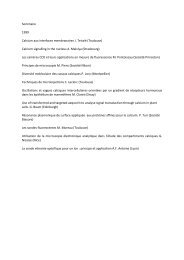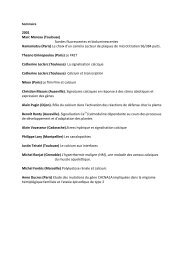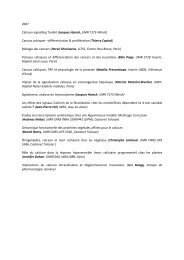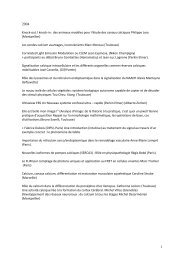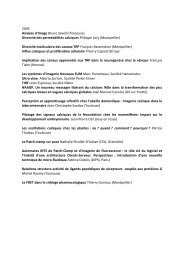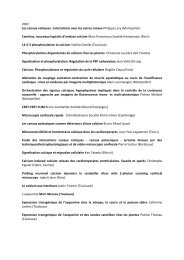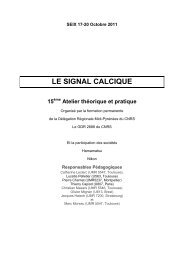SEIX 17-20 octobre 2005 - Atelier Calcium
SEIX 17-20 octobre 2005 - Atelier Calcium
SEIX 17-20 octobre 2005 - Atelier Calcium
You also want an ePaper? Increase the reach of your titles
YUMPU automatically turns print PDFs into web optimized ePapers that Google loves.
UNE NOUVELLE CAMÉRA PAR HAMAMATSU : ELECTRON MULTIPLYING<br />
CCD C9100 HIGH SPEED WITH LOW LIGHT LEVELS<br />
Bruno Combettes<br />
Hamamatsu Photonics France rue du saule trapu, parc du moulin de Massy, BP 229 91882<br />
MASSY Cedex<br />
• Sensor is designed based on the frame transfer back thinned CCD technology.<br />
• Multiplication register is added on the serial register.<br />
• In the multiplication register, up to 50 volts is applied to the one of charge transfer<br />
gate (GS) in order to get the multiplication gain.<br />
• Electrical field under the transfer gate (GS) accelerates the signal electron and<br />
energetic collision occurs in the silicon matrix.<br />
• Such collision will result in an occasional extra electron in the transferred charge.<br />
• This is called IMPACT IONIZATION<br />
• Every stage in the multiplication register has a statistical chance of 1.0% to 1.6% of<br />
creating an impact ionization event.<br />
• When multiplied by 500 steps ,for example, this generates several thousand times<br />
“gain”.<br />
• Mathematically gain is given by G=(1+g)N<br />
– where N is the stage number in the multiplication register and g is the<br />
probability of generating a secondary electron.<br />
– For example, N is 500 and g is 1.5%(0.015), then G is <strong>17</strong>10.<br />
• The normal read noise of a camera becomes “relatively” very small compared to this.<br />
• High speed readout at low intensity with low “relative read noise” is the main<br />
advantage of this technology.<br />
• Advantage<br />
– Readout noise is constant and fixed.<br />
– Gain is controllable.<br />
– When signal is gained up bigger than Readout noise, then it relatively readout<br />
noise becomes less than 1 electron.<br />
Cooling is the most important technology for EM-CCD.<br />
• Why?<br />
– Dark current is the part of signal.<br />
– At high gain, dark current becomes a main source of back ground noise.<br />
– EM Gain is the function of temperature. Need -50 degree C cooling to get<br />
<strong>20</strong>00 times gain.<br />
– Sensor gain is strongly affected by the sensor temperature and it must be very<br />
stable against ambient temperature movement.<br />
– Only very stable sensor temperature realizes the quantitative measurement.<br />
49



